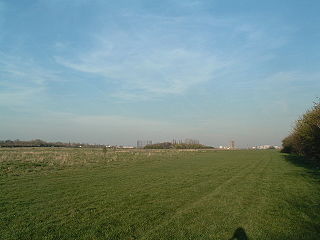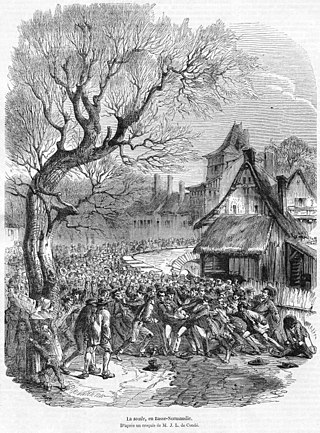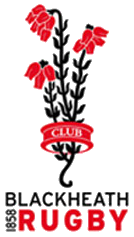
Wormwood Scrubs, known locally as The Scrubs, is an open space in Old Oak Common located in the north-eastern corner of the London Borough of Hammersmith and Fulham in west London. It is the largest open space in the borough, at 67 hectares, and one of the largest areas of common in London. The eastern part, known as Little Wormwood Scrubs, is cut off by Scrubs Lane and the West London line railway. It has been an open public space since the Wormwood Scrubs Act 1879.

The Rugby Football Union (RFU) is the national governing body for rugby union in England. It was founded in 1871, and was the sport's international governing body prior to the formation of what is now known as World Rugby (WR) in 1886. It promotes and runs the sport, organises international matches for the England national team, and educates and trains players and officials.

The history of rugby union follows from various football games long before the 19th century, but it was not until the middle of that century that the rules were formulated and codified. The code of football later known as rugby union can be traced to three events: the first set of written rules in 1845, the Blackheath Club's decision to leave the Football Association in 1863 and the formation of the Rugby Football Union in 1871. The code was originally known simply as "rugby football". It was not until a schism in 1895, over the payment of players, which resulted in the formation of the separate code of rugby league, that the name "rugby union" was used to differentiate the original rugby code. For most of its history, rugby was a strictly amateur football code, and the sport's administrators frequently imposed bans and restrictions on players who they viewed as professional. It was not until 1995 that rugby union was declared an "open" game, and thus professionalism was sanctioned by the code's governing body, World Rugby—then known as the International Rugby Football Board (IRFB).

Guy's, Kings and St. Thomas' Rugby Football Club ("GKT") is the name given to the modern amalgam of three formerly distinct hospital rugby clubs each with a long history, having all been founded in the nineteenth century. The teams from Guy's Hospital and St Thomas' Hospital were the first to merge following the union of their respective Medical Departments. When King's College Hospital also merged in 1999 the King's College Hospital Rugby Football Club opted to remain separate and in so doing became an open rugby club that no longer represented the Hospital Medics. GKT is notable for having been part of the twenty-one founding members of the Rugby Football Union, and across its joint history has produced many international players.
Clapham Rovers was from its foundation in 1869 a leading English sports organisation in the two dominant codes of football, association football and rugby union. It was a prominent club in the late 19th century but is now defunct. The club played variously on Clapham Common, Tooting Bec Common and Wandsworth Common and wore a cerise and French-grey kit.
The Brisbane Football Club is a defunct football club, formed in May 1866 in the colonial capital of Brisbane. Brisbane FC was the first known football club of any code in the Colony of Queensland. It was the first club outside Victoria to adopt what was then known as the 'Victorian rules' football from 1866. It is also the first recorded club to have played multiple football codes in Queensland, including soccer (1867–1870) and rugby (1876–1879).
Reginald Halsey Birkett was an English footballer who played for Clapham Rovers, as well as the English national side. He also played international rugby union for England in 1871, in the first international rugby match. In this match he scored England's first try.
The Gipsies Football Club was a short lived 19th century rugby football club that was notable for being one of the twenty-one founding members of the Rugby Football Union, as well as producing a number of international players in the sport's early international fixtures.
The Marlborough Nomads was a 19th-century English rugby union club that was notable for being one of the twenty-one founding members of the Rugby Football Union. They also supplied a number of players for the sport's early international fixtures.
The West Kent Football Club was a short-lived 19th century rugby football club that was notable for being one of the twenty-one founding members of the Rugby Football Union, as well as producing a number of international players in the sport's early international fixtures.
Ravenscourt Park was a short lived 19th century English rugby union club that was notable for being one of the twenty-one founding members of the Rugby Football Union, as well as supplying a number of international players for the sport's early international fixtures.

King's College Hospital RFC is an open rugby union club founded in the 19th century as a football club whose representatives were made up of medics from King's College Hospital. In its original form it was one of the twenty-one founding members of the Rugby Football Union, and produced a number of international players in the sport's early international fixtures. The merging of King's College Hospital medical department in 1999 with the already merged Guy's Hospital and St Thomas' Hospital led to the creation of Guy's, Kings and St. Thomas' Rugby Football Club, an amalgam of three formerly distinct hospital rugby clubs each with a long history. King's College Hospital Rugby Football Club opted to remain a separate entity in so doing became an open rugby club that no longer represented the Hospital medics.
Queen's House was a 19th-century rugby football club that was notable for being one of the twenty-one founding members of the Rugby Football Union, as well as producing a number of international players in the sport's early international fixtures.
The Flamingoes was a 19th-century rugby football club that was notable for being one of the twenty-one founding members of the Rugby Football Union.
Belsize Park was a short-lived 19th century rugby football club that was notable for being one of the twenty-one founding members of the Rugby Football Union. Although there is no direct link between this club and the modern day Belsize Park RFC which was founded in 1971 the modern club do deem themselves a re-establishment of the former and thus could be considered spiritual successors to the former club.
Lausanne was a 19th-century football club that fielded teams playing both the association football and rugby football codes. It is notable for being one of the twenty-one founding members of the Rugby Football Union.
Law, or The Law Club as it was also known, was a 19th-century football club that fielded teams playing by rugby football codes. It is notable for being one of the twenty-one founding members of the Rugby Football Union and for producing in a very short life span, a number of international players.
Mohicans was a 19th-century football club that played football by the rugby football codes. It is notable for being one of the twenty-one founding members of the Rugby Football Union.

Francis Luscombe was a rugby union international who represented England from 1872 to 1876. He also captained his country.





